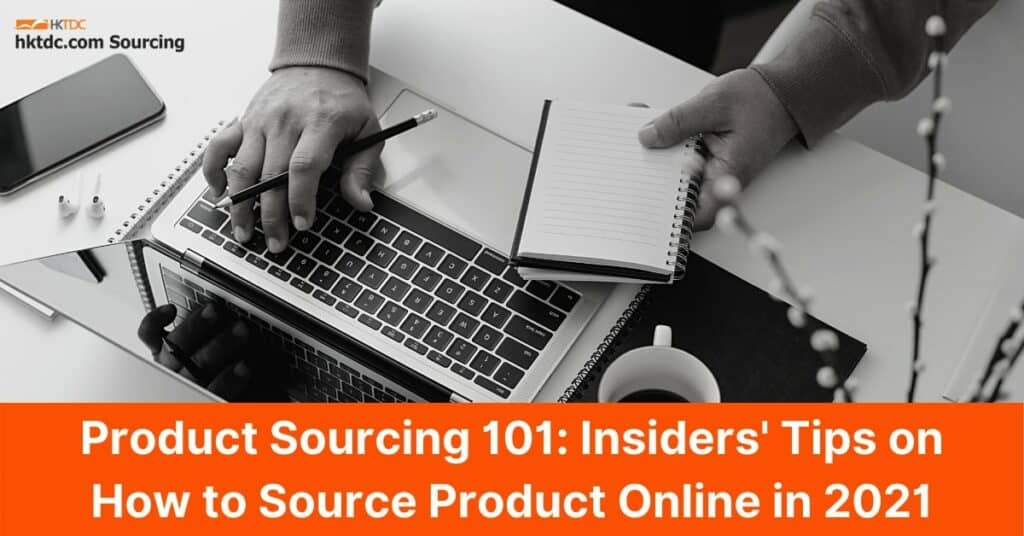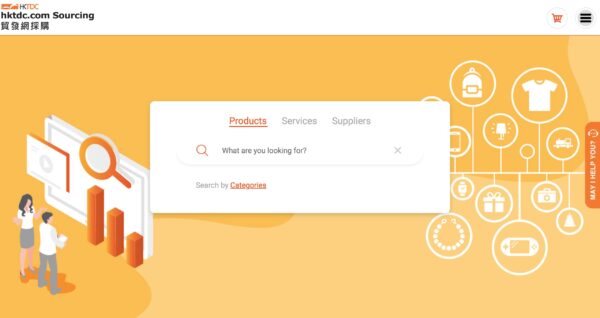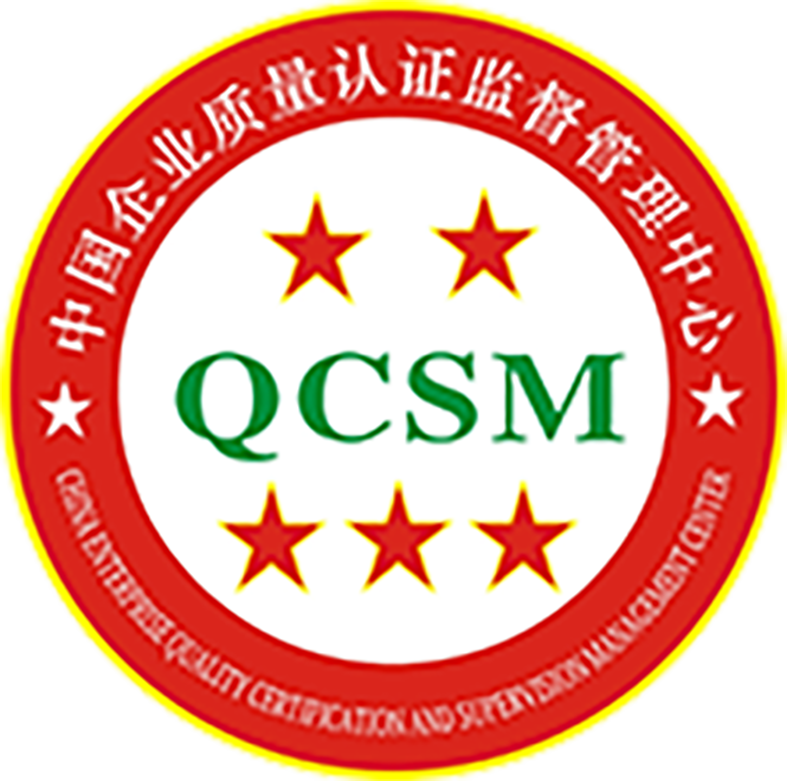Product sourcing. It can’t be too different from identifying trending products, finding a supplier, placing orders, and selling them online. Sounds simple enough.
If that’s your idea of how to source products, then you’re definitely underestimating the work it takes.
Anyone could source products online. But how to source products of good quality at a great price with good profit margins guaranteed? To achieve that, you need to do plenty of research and expect a lot of trial and error.
This is product sourcing 101. In this crash course, we will go through how to source products, share top insiders’ product sourcing tips, and ultimately help minimize your e-commerce errors yet maximize your returns.
Product Sourcing 101: What is product sourcing; where to begin
Product sourcing is the process by which a business owner finds a good product to sell. It requires identifying reputable and reliable suppliers, as well as trading at good prices. The process of product sourcing involves various stages.
From doing research on a target product, considering your budget and evaluating product prices and costs, to negotiating with suppliers for the best deal. Each stage makes a significant impact, and if well-handled, product sourcing can result in pinning down the best-selling products, from reputable suppliers, at great prices that can bring great profit returns.
It is easier said than done. Often in the process of product sourcing, sellers can end up with unreliable suppliers, unknowingly paying hidden costs, misrepresentation or receiving low-quality products. To be ahead of the game, implementing product sourcing strategies is crucial to your e-commerce success.
A great place to begin would be supplier outreach: connect with a product sourcing agent with suppliers of great expertise and niches, especially one that is based in China if you are sourcing products from China.
1. Connect with a wholesaler
By developing a close relationship with an experienced wholesaler, you stand a great chance of discovering unlimited, unique products without having to manufacture the product prototype yourself.
Also, because of the huge quantities of products factories make for a batch, most wholesalers will only produce what they already know for sure would sell well. With this insight, you know there is a market and guaranteed demand for your product. The only downside is that wholesalers, by nature, will only offer products in bulks due to the higher initial production costs. This means that e-commerce sellers will have to pay more upfront and hold greater quantities of the product. This could also invite potential competition from other sellers who source products from the same wholesaler.
HKTDC has a resourceful network of wholesaler connections, readily available for you to reach out. For more information, head over to our Sourcing website.
2. Trade with a manufacturer
Working directly with manufacturers cuts out two things: the potential middleman who could be a communications barrier; the additional incurring fees where mediators and transports cost. Trading with a manufacturer will give you a much better price in ordering products. This is often the case for businesses sourcing products from China. However, the catch would be to fulfil the minimum order quantities (MOQ). This could be very challenging for smaller businesses with smaller budgets.
To find one manufacturer that you can reliably trade with at a reasonable price, visit HKTDC Sourcing for its ample connections.
3. Attend trade shows
Nothing beats sourcing product first-person. Attending trade shows, exhibitions, and conferences are great opportunities to do market research and observe trends in the market. More importantly, it is the opportunity to interact and build relationships with manufacturers, wholesalers and other independent retailers. They often have insights and access to unique products that are not yet common in the market.
Take advantage of the opportunity to inspect the product first-handedly. Talk to the seller and supplier to gain an insider’s insight. This way, you can better understand any potential issues, such as the product’s demand. But the catch of trade shows is they do not take place regularly. This approach may not be frequent enough to catch up with market happenings.
For upcoming trade shows, stay tuned to HKTDC Events for latest updates.
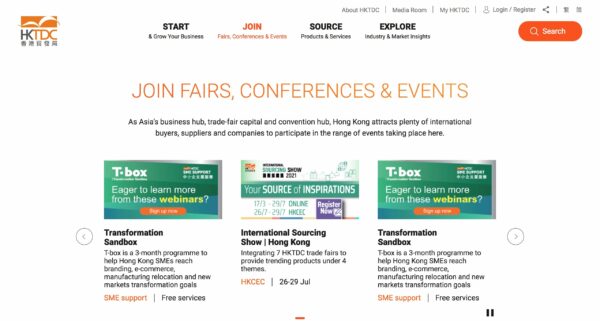
What is the process of product sourcing?
Starting one’s own online business and sourcing what one likes is always exciting. Yet, it is crucial to get this step-by-step procedure right in order to kickstart your business on the right foot.
From market demands, minimum order quantities, vendors’ output and efficiency, to delivery costs, each of these factors can immensely affect your business. To get ahead for product sourcing success, preparation and doing studies in advance is your safest bet.
1. Study Trends and Market Demands
Before you place a product order, you want to make sure there is enough market demand that could boost your store’s sales and overall growth or particular products that work better for certain types of stores.
Find out what trends in your product category at the moment, and from there, identify your market rivals. This can again be done by cracking Google Trends, which we have another guide on.
Ask yourself: What are you really looking for? What would your ideal customer like to see on social media? Would you receive reviews from various platforms? How can you best engage with them? Can what you sell relate to who they are?
Products with proven sales track record and established market demand are safer choices for small companies. Compared to introducing a new product into the market, the former guarantees returns and saves marketing efforts. Thus, better look into what shoppers often choose before sourcing.
Using platforms like Amazon or Internet Search Results could provide great customer insights. Both platforms provide great in-depth analysis and free resources online.
2. Budget Wisely
Once you have compiled a list of potential products, research your competitors’ pricing. This would help estimate your expenses and budget before contacting suppliers or begin product sourcing. In general, you can approximately estimate the cost at half the retail price.
With smaller budgets and a smaller room for storage, a start-up can look for these favourable terms in a supplier:
- No-fuss, easy to work with (e.g. ordering and shipment process)
- Small minimum order quantity (MOQ)
- Quick response and reorder processing time
- Net installment periods of 30-, 60-, or 90-day.
- Prepayment Discounts
- Free delivery for orders exceeding a certain amount.
3. Research Suppliers Options
This is where you put all our processes and tips above into practice. From searching online wholesale vendors, attending trade shows, sourcing products from China or visiting buyers’ markets, target your product. Alternatively, try other techniques such as drop-shipping, working with wholesalers, or hiring manufacturing.
4. Request Samples
If you would not make a huge investment without seeing or trying the actual product – say a house or a car – chances are you probably should not do so with product sourcing, either. A retailer would not sell a product if he/she had an adverse first-hand experience from the product. One common practice with vendors is to always request samples. This would help you get some reviews from your coworkers, first-hand experience and review the product closely as users. It is also good to observe how the supplier handles matters before you begin a long-term partnership.
Generally speaking, if a company processes sample orders appropriately and delivers on time, chances are this seller is fairly reliable. Otherwise, trying a different one may be a wise move. Sample-requesting is a crucial step in your product sourcing process, both in terms of sourcing strategically and assessing product quality.
Likewise, you can inspect product quality in person at trade shows or wholesale markets. Even better, showrooms will even have a representative standing by and providing samples for close inspection.
5. Negotiate for Better Terms
Prices can vary, depending on with whom and how you negotiate. Always factor in the key pieces of information such as prices, working terms, and unique selling points. Also, get yourself a better deal by initiating discounts on prepaid orders as you negotiate or other logistically favourable terms, such as extending payment terms, free shipping packages, and more. All these terms can bring your business cost lower and optimize your budget expenses.
Bargaining is always a good idea, especially if you order in lots. Try requesting a trial run in the form of asking specific units to be trialed in your store. This way, you can put the product’s sales performance to test. Running a trial on certain products instead of the whole catalog can be a great deal.
6. Review, Review, and Review
Reviews upon completing the trial run with the supplier is a critical step. By reviewing the product’s potential, such as product quality and user feedback, as well as the supplier’s performance on customer service and delivery operations, this review should determine whether it is worth closing a longer-term partnership deal with this particular supplier.
Alongside, it is good to have a list of other suppliers as backup alternatives.
As product sourcing patterns can change anytime, unexpected incidents like such company mergers or shutdowns can take place overnight. Having backup suppliers in such circumstances can avoid such hiccups affecting the product sourcing process or product quality.
By doing so, not only do you ensure obtaining products for your business, but you also guarantee customer success.
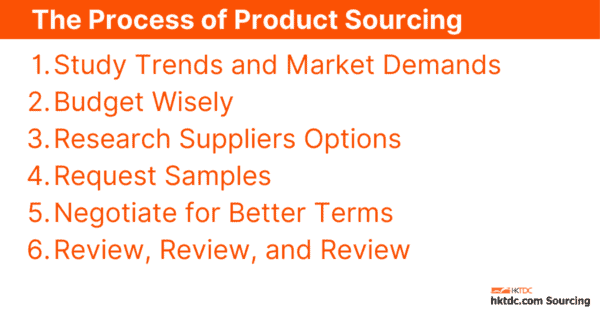
Top Product Sourcing Tips to Streamline your Process
To ensure a greater shot at e-commerce success, here we have some product sourcing tips for cutting out some trial-and-error:
Conduct in-depth research
Know your business model thoroughly, and find a product sourcing system that suits you best. For example, compare the pros and cons of working directly with wholesalers to manufacturers. See which method may give you better control over your inventory.
Product sourcing is more than quality and cost. Behind the scenes are systematic processing, networking, terms negotiations, logistics and more. Gathering more information in advance augments your chances of finding your best product sourcing method.
Conduct competitor analysis
Study your competitors’ product sourcing model and build your framework based on theirs. This way, you can skip building one from scratch and avoid foreseeable errors.
Your competitors’ product sourcing method is not something you can easily find online. But keep asking around – surely you will get some hints on their strategies. Often the best competitor analysis is to outreach your competitors’ customer service to ask for more information, such as where and how they source their products.
Replicate from a successful model
Replicating from a proven sourcing model will set you ahead in the e-commerce world. Look into your competitor’s sourcing strategies or your top-of-mind successful e-commerce business models. Where and how do they purchase the product? Do they source from brands or lesser-known wholesalers? Do they sell handcrafted products, or do they white-labeled the products? Replicate what is already working, and skip experimenting with models.
Have a Plan B
Don’t put all your eggs in one basket. Investing in one sole product comes with a risk of exceeding market demand or that its demand suddenly hits its peak. To avoid such business nightmares, make sure to source another potential product to sell together with your initial product. Ask yourself: are there other similar products? If yes, this could make a great cross-selling strategy.
What’s Next?
If you are running a small and medium-sized enterprise, you may need to start selling the product online. Here we would like to share you 2 e-commerce tips:
Send Free Samples to Influencers
Word of mouth is always a good strategy. By sending a free sample of your product to influencers within your industry, you can leverage the influencers’ platform reach and find new audiences. Daniel Wellington is the epitome of product- seeding success. By getting top influencers worldwide to feature their product, the brand has become a must-have item for any Gen Y elite and became a huge retail success. Try sending in samples as a small gift in exchange for a mention.
Start Blogging
Free, valuable content is the key to build trust and authority in your brand. It is also the key to draw people to visit your website. Create quality content for your target product end-user to answer the queries people have about your products and industry. For example, Shopify’s blog should focus on e-commerce and drop shipping, as its potential customers might be interested in learning about that field. In the long run, content goes a long way.
For more in-depth product sourcing tips and tutorials, visit HKTDC Digital Academy and explore our free resources.
Conclusion
Throughout our product sourcing 101 guide, we broke down the whole process step-by-step: identify good products, connect with good suppliers, negotiate the prices. On top of that, we shared some insider product sourcing tips to minimize the chance of making beginners’ errors.
We’ve covered the importance of building great relationships with product sourcing agents, product sourcing strategies, and tips on optimizing your strategy. Together with our guide to finding trending products, surely you are ready to kickstart your business on the right foot.
Summary: Tips for Product Sourcing 101
- Research is king. Identify a strong, profitable product to lower your risk of investing in unpopular, slow-moving products.
- Cross-check your research and verify your assumptions with hard data. Take reference to actual sales data and competitor research carefully.
- Establish close, sustainable relationships with reputable sellers.
- If you have succeeded in product sourcing and your business turns profitable, optimize your business by upgrading your customer experience.


